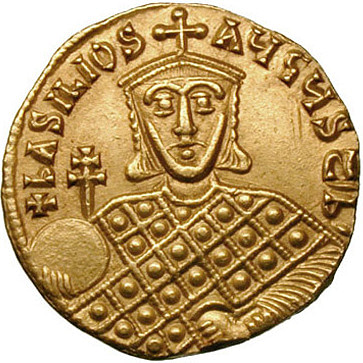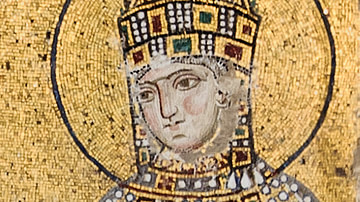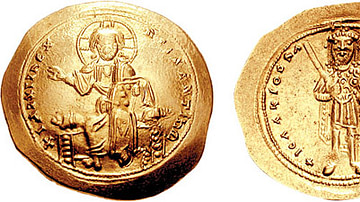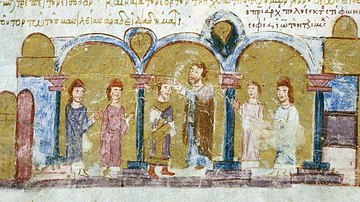
The Byzantine Emperor ruled as an absolute monarch in an institution which lasted from the 4th to 15th century CE. Aided by ministers, high-ranking nobility, and key church figures, the emperor (and sometimes empress) was commander-in-chief of the army, head of the Church and government, controlled the state finances, and appointed or dismissed nobles at will. The position was conventionally hereditary but new dynasties would be founded throughout the medieval period.
Living in the sumptuous Great Palace of Constantinople, the emperors enjoyed fabulous wealth but also great risk that, in troubled times, they could be removed by a usurper, imprisoned, blinded, or murdered. Many emperors founded lasting dynasties or achieved even longer-lasting fame as great rulers, and these include Constantine I, Justinian I, Basil I, Basil II, Alexios I Komnenos, John II Komnenos, Constantine VII, and Leo III. Still others gained infamy for their misrule, military incompetence, and bloody reigns: Empress Irene, Nikephoros I, Anastasios I, Constans II, Constantine V, and Leo I.
Coronation
The coronation ceremony of Byzantium developed from the simpler ceremony of ancient Rome where the newly crowned emperor was acclaimed by the army who raised their shields in salute. The military flavour of the ceremony would continue into the 6th century CE but an important and lasting addition was the role played by the Patriarch of Constantinople from the 5th century CE onwards. The bishop would pray over the diadem or crown, bless the imperial insignia, and anoint the emperor's head with myrrh. It became a convention for emperors to crown their heir while still on the throne themselves, in which case they would crown their son, but if the new emperor's father was already dead (or the throne had been usurped) then the bishop laid the crown on the new monarch's head and anointed him with the sign of the cross. When proclaimed emperor, the gathered Byzantine nobility would then bow in homage, the proskynesis.
Within a few centuries, and perhaps in emphasis of the emperor's role as all-powerful, the bishop was relieved of this duty and the emperor crowned himself. This coincided with the moving of the ceremony from the Hippodrome of Constantinople to the Hagia Sophia church from the mid-7th century CE (although empresses were crowned in the Augustaion forum and Church of Saint Stephen). With these two changes, it was made more obvious to all that the emperor was appointed by God. A third connection between the ruler and the church was the often deliberate scheduling of a coronation on an important Christian feast day. Indeed, the whole coronation became a religious ceremony with Holy Communion taken and prayers of blessing said.
Besides the crown, the emperor had special robes for the occasion, the long chlamys cloak which was fastened at the wearer's right shoulder. The chlamys would ultimately be replaced by the mandyas, a long cloak fastened at the front of the neck and more closely connected with ecclesiastical costumes.
Titles, Regalia & Clothing
The emperor was known by several titles over the centuries. As Byzantium was, in effect, the Eastern Roman Empire, the Latin title of imperator was converted to the Greek autokrator. From the 7th century CE the title of basileus, meaning emperor, was adopted instead, actually stolen from Persian rulers. The female equivalent was basilissa. Byzantine emperors jealously guarded their titles and prohibited any foreign rulers from adopting similar ones. Charlemagne, the 8th-century CE King of the Franks, unfortunately, could not be prevented from adopting basileus, and so Byzantine emperors distinguished themselves by extending their own title to basileus ton romaion (Emperor of the Romans)
Aside from his jewel-encrusted diadem and the finery of his embroidered robes, the emperor's regalia included the magnificent jewelled brooch to fasten his cloak. This piece of jewellery was composed of a large central stone set in a circle of smaller ones with three jewels suspended from it. The brooch can be clearly seen in the 6th-century CE mosaic panel depicting Justinian in the Church of San Vitale in Ravenna, Italy. Another piece of the imperial regalia was a gold belt sparkling with gems.
As the nobility became even more garish in their own attire and equipment, so the emperors became concerned that they were not outshone before the public. Justinian I (r. 527-565 CE) even issued a decree that nobody except himself could embellish their belt or their horse's bridle and saddle with pearls, emeralds, or hyacinths. To make sure everyone complied with the new fashion rules, the punishment for ignoring them was death and a fine of 100 lbs of gold. The emperor was also distinct in one other area - the colour of his clothes. Tyrian purple was a dye produced from the murex shellfish, and it took so many shells to produce a decent quantity of dye that it was tremendously expensive.
Purple became even more closely associated with emperors when Constantine V (r. 741-775 CE) added a new chamber to the imperial residence in the Great Palace of Constantinople which was lined with porphyry, a rare purple-laced marble. This room was used thereafter for royal births and gave rise to the phrase porphyrogennetos or “to be born in the purple” meaning the person had a legitimate claim to the throne. Finally, even in death, the emperor was distinguished by being the only person to be buried in a sarcophagus of purple porphyry.
The Imperial Residence
For most of the empire's history, the official residence of the emperor, his family and court, was the Great Palace of Constantinople. Located along the city's sea walls and first built by Constantine I, the palace would become a sprawling magnificence over the centuries and include a golden throne room, reception halls with clever automata of animals and birds, chapels, a barracks, treasuries with booty from all the empire's wars and conquests, sacred holy relics, Roman baths, and fountained gardens. There was a communicating wing which connected the complex to the Hippodrome and a huge monumental gate topped with the largest icon in the city, a golden figure of Christ. Fitted out with exotic marble, fine mosaics, and magnificent statues, the palace was designed to impress locals and foreign visitors alike.
A Remote Figure
The coronation was the first of the many public events where the emperor would be seen by the people, but the majority of those which followed would be just as carefully orchestrated whether they be appearances in the Hippodrome or audiences granted to visiting ambassadors. Indeed, the accessibility of the emperors would be reduced by this pomp and circumstance, enhancing their image as a unique individual chosen by God to rule the empire. This withdrawal had consequences for government, too, as here described by the historian T. E. Gregory:
As the emperor withdrew into the narrow confines of palace and court, those who were close to him naturally gained considerable real power, though not always the prestige that went with it. Thus, the members of the emperor's family, especially his wife and mother, and the chamberlains and other domestic servants (who were often eunuchs) gained appreciably in power. They frequently controlled access to the emperor, and individuals who wished to present petitions or seek the ear of the emperor often had first to secure the favor of these influential people (41).
Very few of his subjects might have ever seen the emperor in person, but one thing most people saw across the empire was his image. On coins, medallions, weights, plaques, mosaics, and sculpture, the emperor's likeness was everywhere. Another visible aspect of an emperor's reign was their support for the arts and patronage of scholars. Buildings were erected, old ones refurbished, new manuscripts produced, and lands donated to the church and monasteries. The common people's best chance of catching a glimpse of their emperor was when he rode to church, especially on important holidays like Easter, when traditionally the ruler would throw gold coins into the crowd.
Government
The emperor was assisted by various ministers and advisors:
- the quaestor or chief legal officer
- the magister officiorum who looked after the general administration of the palace, the army and its supplies, and foreign affairs
- the cursus publicus who supervised the public post
- the comes sacrarum largitionum who controlled the state mint and supervised customs houses and mines
- the comes rei privatae who looked after the imperial estates
- the Urban Prefect who was, essentially, the mayor of Constantinople
- and the many imperial inspectors who were dispatched to the provinces to make sure laws and policies were being respected there.
Perhaps the most senior figure in the empire besides the emperor and the Patriarch was the Praetorian Prefect of the East to whom all regional governors of the empire were accountable to. The regional governors supervised the individual city councils or curae, but these could directly petition the emperor so that there was both a direct and indirect chain of authority through which imperial policy was transmitted to the ordinary people.
The emperor's main tool of government besides the individual officials mentioned above was the Senate of Constantinople and particularly the small group of elite aristocrats who made up the Senate's sacrum consistorium. The emperor was, in theory anyway, supposed to consult the consistorium on matters of state importance.
In the 7th century CE, as the empire was increasingly threatened by its neighbours, the Emperor Heraclius (r. 610-641 CE) permanently changed this system so that regional governors - now, in effect, provincial military commanders (strategoi) - were directly responsible to and reported to the emperor himself, and the Praetorian Prefect was abolished.
Changes of Emperor
The Byzantine emperor was considered to have been selected by God to rule the empire and was thus given the right to pass on the role to his male (or even female) children but there were many cases when ambitious military men took advantage of economic strife or a series of military defeats at the hands of foreign powers to seize the throne for themselves by violence. With the backing of the army or a large section of it, such men had the power to halt the dynastic line and start a new one of their own. As the historian C. Mango here summarises, the emperor, and particularly unsuccessful ones, always had to be on the lookout for usurpers:
Of the thirty-nine emperors who ruled between 780 and 1204, nineteen were forcibly deposed, six through outright murder, with another two dying as a result of blinding, the standard method of disqualification. Foul play was suspected in at least three other imperial deaths, and of the hundreds of failed conspiracies and revolts, at least eight posed major military challenges to the incumbent regime. (201)
There was then, a clear ideological separation between the institution of the emperor and the person who actually held the office. Faces might change but what was most important was a continuity of government and, above all, economic and military success. Emperors often used the names which recalled illustrious predecessors, Constantine was adopted by eleven rulers, for example. Customs and traditions were also maintained such as Roman baths, architecture, monumental sculpture, chariot racing, and the use of Latin and Attic Greek, which all helped create the illusion of continuity going back to the earliest Roman emperors of the west. Further, even those who usurped the throne by violent means were almost always high-ranking military men, close to the emperor and familiar with the inner workings of government. Upon acquiring the throne, usurpers very often sought to legitimize their position by marrying a member of their predecessors family and lavishly refurbishing the ancient monuments of their capital. Through this carefully orchestrated continuity, the position of Byzantine emperor was able to resist rebellions, invasions, and sieges so that the institution lasted an astonishing 12 centuries before the empire fell to the Ottomans in 1453 CE.









